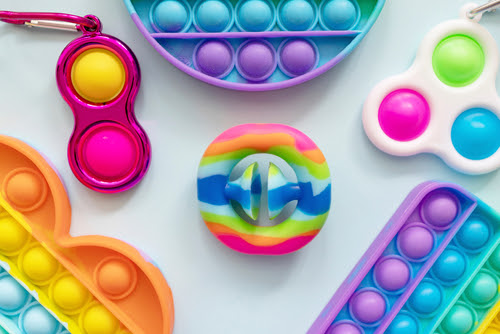Fidget Toys: Helpful or Annoying?
As we shift to spending more time indoors, little things like fidgety fingers become more pronounced and, likely, more annoying.
Sensory fidgets and stress balls can be found everywhere in many shapes, colors, and sizes.
But what do these gadgets really do? And do they even help?
This time I’m not turning to research because I was able to find only one (1!) study on the effectiveness of these gadgets, and it said there was no measurable benefit.
Even so … I’m betting there is more to fidget toys than marketing.
Have you ever gotten the advice to “get something to fidget with?”
First up, what does that mean?
Secondly, how is a ‘fidget’ supposed to help?
Let’s dive into more about each of these questions.
What is a fidget toy?
Typically, these are a category of devices or toys which have a manipulative quality to them. There are so many and the popularity shifts from year to year. Examples include:
- fidget spinners
- bubble-wrap style poppers
- squeeze balls
- moveable beads
- twisting blocks, similar to a Rubik’s cube
They all fall into two distinct sensory categories: pressure-based or activity-based.
How do the fidget toys help?
Depending upon which type of toy, there are different effects. It really is a little bit like eating — are you craving fat, salt, or sugar for a snack?
To help understand the types of sensory ‘snack’ categories, let’s review a few things about hands, fingers, and the nervous system.
The Sensory System Scoop
There are five types of sensory receptors in the skin whose composition and density vary from location to location.
The basic types are:
- mechanoreceptors: sense pressure, tactile smooth/roughness
- thermoreceptors: sense hot, cold
- chemoreceptors: sense oxygen levels
- pain receptors: sense pain
- proprioceptors: sense change of orientation and speed
Within mechanoreceptor types there are different types of responses (faster or slower reacting) and different stimuli responses (pressure based, vibration based or stretch based.) Here is a more detailed discussion about the somatosensory anatomy.
So which type of fidget toy is best?
It depends. Is your nervous system craving more sensory input from a stretch system, a vibration system, or a pressure system?
To decide which is best, tune-in to how you or your child feels during or after using one of the toys.
- If you feel calmer by squeezing, then you probably like pressure-based fidgets.
- If you to pay attention more easily by tapping or pulsing, then vibrational toys are your thing.
- If helping to calm or focus results from playing with moving parts, twisting and turning, then the stretch based toys are the right choice. (Your finger muscles stretch as you manipulate the toy.)
How Bridging® can also help
Fidgets help generate missing sensory information desired by the brain. Bridging® turns these sensory system components on and connects them. Essentially the fidgets are an external support, whereas Bridging® is an internal support.
When using fidgets becomes annoying or distracting it’s time to consider a different solution. With Bridging® there are a few specific ways better micromovement function takes the place of fidgets.
- The strength of the hands comes from forearm and shoulder connections. Pressure fidgets are likely trying to stimulate this.
- The pulsing from tapping or vibrational activities often serves to align and strengthen nervous system pathways.
- Manipulative toys creating stretch responses in fingers create the survival sensory input the brain is monitoring as it guards our safety.
Our clients consistently see function improve as finger, hand, and arm muscles re-connect and function better. The associated sensory information produced by this function becomes more predictable, continuous, and modulated. Bridging® puts the pieces together the way they are supposed to work!
Tapping or constantly moving hands driving you crazy? Complete our intake form and we’ll get in touch to explain how Bridging® can help your specific concerns.

